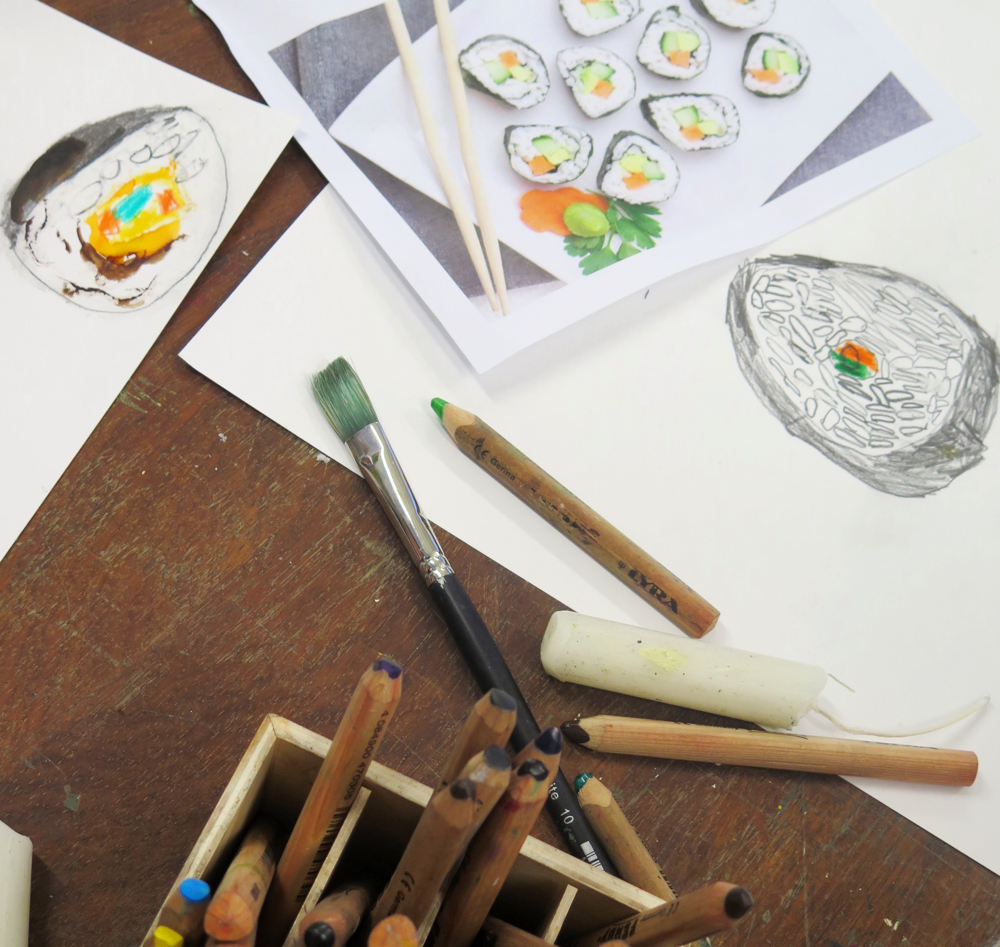Japan: Making Sushi – Recycled Style!
This resource is part of a collection of resources called Teaching Art to Year Three.
Inspired by research into Japanese culture, children explored the potential and limitations of paper and recycled materials, learning through play and experimentation to make 3D forms. The outcomes of this process were used to inform work created in a second medium of clay, using kitchen equipment to shape the clay and add textures.

Context
This project developed from other work that was inspired by Japan. The children found the culture interesting and inspirational. Pupils made their own sushi using seaweed, rice and vegetables on bamboo mats. They translated this three ways into clay and found materials.
Aims
- use sketchbooks to gather information from direct observation.
- explore the limitations and possibilities of several recycled and found materials. Thinking smarter to make rapid progress.
- produce an individual tactile response using clay and everyday kitchen utensils as tools.
- engage pupils – developing several pieces through various materials by working on a theme.
- develop a project in which all abilities can feel a sense of achievement.
- deepen learning about a culture.
Who are the sessions aimed at?
The sessions were run with children aged 8 in Year 3. The resources below can be used with children aged 7 to 11 (older KS 1 children and KS 2 children).

Which areas of exploration are covered?
- Drawing from observation.
- Colour blending and controlling transparency and consistency.
- Exploring new materials to use for making art – considering scale, texture layering and natural colour.
- Learning through play and experimentation.
- Appreciation of cultural difference.
- Working spontaneously.
- Making informed and independent material choices.
- Working in 3D, learning to manipulate materials to meet their intentions.
How much time is needed?
Each of the sessions took an hour with the whole class. If you were working with a smaller group of children the activities may take less time. If time is limited, you may just allocate one hour with one technique, or offer the children three activities organised around the room. The lessons using three materials progressively built on each other and the children developed an understanding of process and materials. If you followed all the sessions you would cover the areas of exploration listed. The teacher could complete more of the preparation, rolling clay, cutting pieces of fabric and foam to select from. Sketchbooks were available in all lessons to continue research drawing and making notes. The lesson could involve the children drawing their labelled plan of intentions first or spontaneous making.

Extension ideas
- The children worked on several Japanese-themed pieces of art simultaneously from research into their culture – food, clothes, houses, rituals, art like we did.
- Use felt-making to make sushi.
Variation
- Any cultural close-up of food could be used.
- Any subject relating to Japanese culture could be drawn.
- 3D – can use salt dough, fimo, air fired clay and coloured with acrylic paint
- More materials to offer are optional- e.g. – soft pencils 4B, graphite powder, and waxy coloured pencils.
- Alternative to screen-printing background could be a string print, cutting shapes from sticky foam, printing with paper straws or pipe cleaners.
- Textured wallpaper samples can be glued around a wide tube, perfect for children to print a repeated design.
TIP
Begin a collecting box and ask children to bring in donations.
Where might the sessions be used?
- Classrooms (as part of art lessons or workshop).
- After-school art club or AG&T group.
- Community groups (i.e. Scouts and Guides).
- Gallery, Museum or Art Organisation workshop.

Materials and Equipment preparation
- Scissors, wire, glue gun, PVA, masking tape, cocktail sticks, small cable ties.
- Upholstery foam/fabric from sample books.
- Coloured tissue, cellophane, newspaper, wool.
- Hessian, netting, washing-up sponges, cloths and rubber gloves.
- Inks.
- Clay, kitchen equipment and 3 glaze colours (you can use paint and varnish or PVA for glaze instead if air drying clay).

ACTIVITY
Week 1: PLANNING AND PAPER MODELLING IN MINIATURE
They looked through available materials and discussed ideas before working from photographs of sushi to draw labelled plans of their model. Ideas for materials and fastenings were noted. Make miniature sushi samples with recycled used materials – beginning with rolled, flattened newspaper and adding upholstery foam, cleaning cloths and wool, shredded paper securing with a little piece of masking. We placed them in small boxes we lined with Japanese paper.
To access all content, I would like to join as…
AccessArt is a UK Charity and we believe everyone has the right to be creative. AccessArt provides inspiration to help us all reach our creative potential.


